
Pablo Picasso Dans l’atelier 1954

Funny how opinions of Russia revert to communism all the time.
• Putin: US Routinely Meddles In Russian And Other Elections (Zuesse)
The neoconservative American Jan Wenner’s Rolling Stone magazine headlined on June 16th about these Showtime interviews, «10 Most WTF Things We Learned From Oliver Stone’s Putin Interviews», and sub-headlined: «From denying any involvement with U.S. election hacking to Putin’s love of Judo and Stalin, our takeaways from these truly baffling conversations».
Wenner’s reporter opened: “What’s the Russian equivalent of Kool-Aid? Whatever it is, it’s definitely red – and Oliver Stone has eagerly drunk it down. The trailers for The Putin Interviews, Showtime’s four-part series documenting conversations between Russian President Vladimir Putin and Stone, would have you believe that you’re going to hear some pretty hard-hitting stuff as the autocrat and the filmmaker face off, Frost-Nixon style. What we got instead was a series of softballs lobbed lovingly in the direction of one of the most powerful and dangerous men in the world. Except for a few moments, Stone seems serenely unconcerned with anything beyond flattering his subject – and engaging in some supremely one-sided exchanges about history and policy along the way.”
The term «red» in this context refers, of course, to communism, and alleges that Russia is still a communist country. To allow that type of smear to appear in any ‘news’ vehicle, is to expose itself as being actually a propaganda-vehicle, unless the allegation is backed up by solid documentation, which Wenner’s magazine didn’t do — Wenner’s magazine presented no documentation at all, for the inflammatory allegation. The magazine’s presumption was that their readers will simply believe what Wenner’s operation delivers, to be ipso-facto ‘true’.
But any such reader would be welcoming his own deception by Wenner’s propaganda-operation. Evidently, successful magazines can insult their own subscribers’ intelligence, so long as it’s done in ‘the right way’ — the subscribers won’t despise the publisher for trying to deceive them about such important matters as what countries to invade, or whether to invade, or why to invade. The U.S. military-industrial complex (MIC) can attract cannon-fodder for its operations, by means of such ‘news’ media to produce dupes for that MIC. During the 2016 U.S. Presidential campaign, Mr. Wenner’s propaganda-machine had ardently campaigned for the neoconservative Hillary Clinton against the moderately progressive Bernie Sanders in the U.S. Democratic Party primaries.
And, then, once she (and her friend Debbie Wasserman Schultz who ran the DNC) managed to steal the nomination from her opponent, Wenner’s operation campaigned for Ms. Clinton against her Republican opponent Trump, who claimed (falsely as it turns out, in lies exceeding Clinton’s own) to be opposed to neoconservatives (whom he has actually loaded into his Administration). Trump now relies upon neocons for his support, but perhaps Wenner and Robert Kagan and other neoconservatives won’t be satisfied until the U.S. government takes control over Russia — which cannot happen except upon all of our dead bodies (WW III) — which is precisely what Hillary Clinton was aiming for (and maybe Trump is, too). That’s how insane the U.S. aristocracy (and its PR organs such as Wenner’s) now is – they’re pushing the world toward nuclear Armageddon.

There will come a point when Russia’s had enough. But they won’t shoot down US planes.
• Russia To Consider US Planes In Syria As ‘Targets’ (News.AU)
Russia says it will now consider US planes in Syria as “aerial targets” and cease communications via a military hotline in a rapid escalation of tensions between the two nations. The Russian defence ministry released a statement Monday afternoon, local time, condemning the US for shooting down a Syrian warplane that had dropped bombs near ground forces supported by the US. The ministry said it would now track all US-led coalition jets and drones found west of the Euphrates River in Syria and treat them as targets. This is a significant development because, while it is not uncommon for the two nations to criticise each other politically, Russia stays in contact with the US-led coalition via a military hotline to ensure there is no unintended military conflict between the two powers in the region.
The statement says that Russia will no longer use the communication channel, designed to avoid incidents in Syrian airspace. “The command of the coalition forces did not use the established communication channel for preventing incidents in Syrian airspace,” the defence ministry said in the statement. Russia said it would now “end co-operation with the American side”. “Any flying objects, including planes and drones of the international coalition, discovered west of the Euphrates River will be tracked as aerial targets by Russia’s air defences on and above ground,” it said. [..] The campaign has often put the US at odds with the regime of Syrian President Bashar al-Assad, which is leading its own attack against IS with air cover support from Russia. Syria is also in the grip of a civil war that has claimed more than 400,000 lives, according to the United Nations.
An American F/A-18 Super Hornet shot down a Syrian SU-22 about 7pm on Sunday. The coalition said the Syrian plane had dropped bombs near its allies, the Syrian Democratic Forces, which were fighting IS south of Tabqah. Russia said the shooting down of the plane was an act of aggression against Syria and called for a “careful investigation by the US command” into the incident. “Repeated military actions by US aircraft against the lawful armed forces of a United Nations member state, under the guise of a ‘fight against terrorism’, are a profound violation of international law and, in fact, military aggression against the Syrian Arab Republic,” the Russian Defence Ministry said. “As a result of the strike, the Syrian plane was destroyed. The Syrian pilot catapulted into an area controlled by Islamic State terrorists. His fate is unknown.”
The coalition said the Syrian warplane had been shot down “in accordance with rules of engagement and in collective self-defence of coalition partnered forces”. The deputy chairman of the Russian Senate’s defence committee, Frants Klintsevich, said there was “no defence” for the US shooting down the plane. “Blatant aggression and provocation. To provoke, above all, Russia. It seems that the US under Donald Trump is a source of a qualitatively new level of danger not only in the Middle East but also around the world,” he wrote on Facebook.

“That well is going dry in the middle of the summer, and without any resolution to the debt ceiling debate, the country will not be able to borrow more to pretend that it’s solvent.”
• Absent Without Leave (Jim Kunstler)
After nearly a year of investigating, the FBI, the CIA, the NSA, the DIA, DHS, et. al. haven’t been able to leak any substantial fact about “Russian collusion” with the Trump election campaign — and, considering the torrent of leaks about all manner of other collateral matters during this same period, it seems impossible to conclude that there is anything actually there besides utterly manufactured hysteria. Now, one might imagine that this intelligence community could have manufactured some gift-wrapped facts rather than just waves of hysteria, but that’s where the incompetence and impotence comes in. They never came up with anything besides Flynn and Sessions having conversations with the Russian ambassador — as if the ambassadors are not here to have conversations with our government officials.
You’d think that with all the computer graphics available these days they could concoct a cineplex-quality feature film-length recording of Donald Trump making a “great deal” to swap Kansas for Lithuania, or Jared Kushner giving piggyback rides to Vladimir Putin in the Kremlin. But all we’ve really ever gotten was a packet of emails from the Democratic National Committee and John Podesta of the Clinton campaign gloating about how nicely they fucked over Bernie Sanders — and that doesn’t exactly reflect so well on what has evolved to be the so-called “Resistance.” The net effect of all this sound and fury is a government so paralyzed that it can’t even pass bad legislation or execute its existing (excessive) duties. That might theoretically be a good thing, except what we’re seeing are individual departments just veering off on their own, especially the military, which now operates without any civilian control.
Apparently General Mattis, the Secretary of Defense, pretty much decided on his own to dispatch another 8,000 US troops to Afghanistan to move things along there in the war’s 16th year. Or did he get President Trump to look up from his Twitter window for three seconds to explain the situation and get a nod of approval? Perhaps you also didn’t notice the news item over the weekend that a US-led fighter plane coalition shot down a Syrian air force plane in Syrian airspace. In an earlier era that could easily be construed as an act of war. Who gave the order for that, you have to wonder. And what will the consequences be? Reasonable people might also ask: haven’t we already made enough deadly mischief in that part of the world? With the US military gone rogue in foreign lands, and the intelligence community off-the-reservation at home, and the Trump White House all gummed up in the tarbaby of RussiaGate, and the House and Senate lost in the shuffle, you also have to wonder what anybody is going to do about the imminent technical bankruptcy of the USA as the Treasury Department spends down its dwindling fund of remaining cash money to pay ongoing expenses — everything from agriculture subsidies to Medicare.
That well is going dry in the middle of the summer, and without any resolution to the debt ceiling debate, the country will not be able to borrow more to pretend that it’s solvent. I don’t see any indication that the House and Senate will be able to bluster their way through this. Instead, the situation will compel extraordinary new acts of financial fraud via the central banks and its cadre of Too-Big-To-Fail associates. In the event, the likely outcome will be a spectacular fall in the value of the US dollar, and perhaps consecutively, the collapse of the equity and real estate markets.

Actual bankers charged? Or is this just more of the sudden anti-Qatar campaign?
• Barclays and Four Executives Charged With Fraud In Qatar Case (BBC)
Barclays and four former executives have been charged with conspiracy to commit fraud and the provision of unlawful financial assistance. The Serious Fraud Office charges come at the end of a five-year investigation and relate to the bank’s fundraising at the height of 2008’s financial crisis. Former chief executive John Varley is one of the four ex-staff who will face Westminster magistrates on 3 July. Barclays says it is considering its position and awaiting further details. Mr Varley, former senior investment banker Roger Jenkins, Thomas Kalaris, a former chief executive of Barclays’ wealth division, and Richard Boath, the ex-European head of financial institutions, have all been charged with conspiracy to commit fraud in the June 2008 capital raising. In addition, Mr Varley and Mr Jenkins have also been charged with the same offence in relation to the October 2008 capital raising and with providing unlawful financial assistance.

The Greeks are the only ones who’ve seen the real face of the EU.
• Two-Thirds Of Europeans Believe EU Should Take Hard Line On Brexit (G.)
Two-thirds of Europeans believe the EU should take a hard line with the UK over Brexit, according to a survey. 65% of those questioned in Belgium, Germany, Greece, Spain, France, Italy Austria, Hungary and Poland said the EU, while trying to maintain a good relationship with Britain, should not compromise on its core principles. The Chatham House-Kantar survey showed just 18% of people in the nine countries – compared with 49% of people in Britain – believed the opposite; that the European commission should aim to keep the UK as close as possible, at the expense of its principles, during the talks, which began on Monday. f those surveyed across the nine continental countries, 57% said the EU had been weakened by Brexit, while 46% felt Britain’s departure would be bad for the bloc. By contrast, 70% of Britons felt the EU would suffer from the UK leaving.
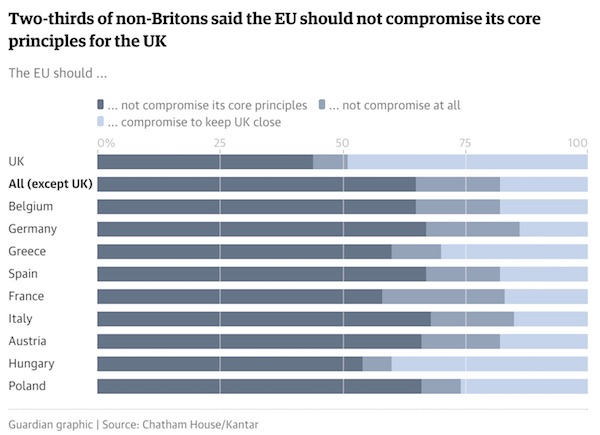
The survey interviewed more than 1,000 people in each of the 10 countries including Britain earlier this year before elections in the Netherlands and France and an economic uptick that have significantly bolstered pro-European sentiment. The election of pro-European centrist Emmanuel Macron in France has in particular given the bloc a boost. The eurozone economy, too, is now growing faster than that of the UK or US. Britain’s confusion over what Brexit strategy to adopt have also helped swing EU opinion. A Pew survey last week found markedly higher approval for the EU since the Brexit vote: 63% of respondents in the 10 EU countries had favourable views about the bloc.
The figures mark a sharp increase from spring last year, with favourable opinions up 18 points in Germany and France, 15 in Spain, 13 in the Netherlands – and 10 in the UK. Only 18% of continental respondents wanted their country to leave the EU. Overall, the survey revealed that more than half (58%) of people in 10 countries believed another EU country might leave the bloc within the next decade. Four-fifths of Greeks, hardest hit by the 2008 financial crisis, backed this view, compared with less than half of Hungarians and Poles. Asked about what they considered the EU’s greatest achievements, the freedom to live and work across Europe and the creation of the border-free Schengen zone came top among continental respondents (both on 17%), followed by European peace and the euro (13%) and the single market (8%).
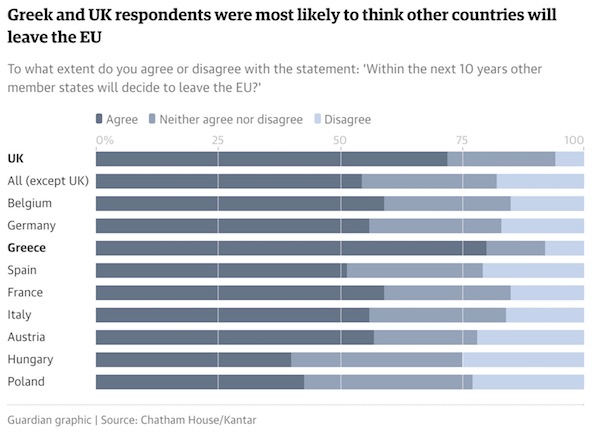

“..almost a million people were employed across the wider automotive industry.”
• Britiain’s Carmakers Face Brexit Cliff Edge (BBC)
The government must secure a transitional Brexit deal to protect the future of the UK car industry, a trade group has said. The Society of Motor Manufacturers and Traders (SMMT) said Britain was highly unlikely to reach a final agreement with the EU by the March 2019 deadline. That meant carmakers could face a “cliff edge”, whereby tariff-free trade was sharply pulled away. It warned the industry would suffer without a back-up plan in place. The EU is by far the UK’s biggest automotive export market, buying more than half of its finished vehicles – four times as many as the next biggest market. UK car plants also depend heavily on the free movement of components to and from the continent.
The SMMT said any new relationship with the EU would need to address tariff and non-tariff barriers, regulatory and labour issues, “all of which will take time to negotiate”. “We accept that we are leaving the European Union,” said chief executive Mike Hawes. “But our biggest fear is that, in two years’ time, we fall off a cliff edge – no deal, outside the single market and customs union and trading on inferior World Trade Organization terms. “This would undermine our competitiveness and our ability to attract the investment that is critical to future growth.” UK car manufacturing generated £77.5bn of turnover last year and accounted for 12% of all goods exports, according to the trade group. It added that almost a million people were employed across the wider automotive industry.

At least divvy up the monopoly money with a little sense of justice, you’d say. The fall will be hard enough already.
• UK Property Owners’ £2.3 Trillion Windfall ‘Created Huge Inequality Gap’ (G.)
A £2.3tn windfall for those lucky enough to own their own homes during the property boom of the 1990s and early 2000s has opened up a deep and widening inequality gap between the generations, a thinktank has warned. Rising house prices that have enriched older generations have priced the young out of home ownership, said the Resolution Foundation, adding that the pattern whereby each generation was wealthier than the previous one had broken down. In a new report, the thinktank noted that the baby boomers born in the 20 years after the second world war were the big beneficiaries of rapidly rising house prices, but had amassed most of the wealth through no skill of their own. Wealth disparities would have “worrying consequences” for the living standards of younger generations, it added.
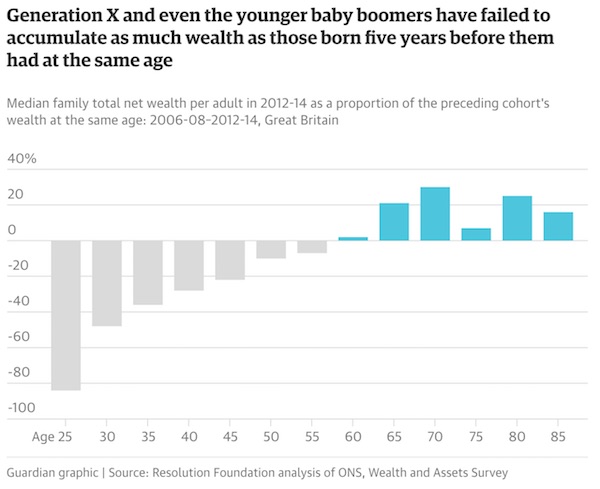
Laura Gardiner, senior policy analyst at the Resolution Foundation, said: “Britain’s pre-crash property boom created a huge, unearned and largely tax-free £2.3tn housing wealth windfall for those old enough and lucky enough to be home owners at the time. But while the property bubble hugely benefited many of Britain’s baby boomers, it has also driven generational wealth progress into reverse by pricing younger people out of home ownership. “Property, pension and financial wealth can provide security and opportunities for families, as well as a decent income in retirement. The failure of younger generations to accumulate wealth in the way that earlier generations have been able to is therefore a huge living standards concern for us all.”
The report found that 82% of housing wealth increases between 1993 and 2012-14 were due to the property boom, which saw the average price of a residential property in the UK rise threefold, rather than through any active behaviour – such as buying, moving house or paying off mortgages. At the boom’s zenith in 2003, one in six of all working property-owning adults were earning more from the rising value of their homes than from their jobs.
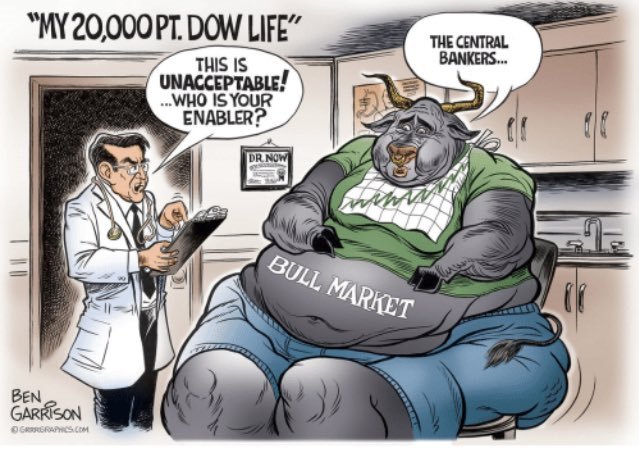

What a great idea! Take your money now?!
• UK’s Co-op Bank In Advanced Talks To Be Rescued By Hedge Funds (G.)
The Co-operative Group’s stake in the Co-op Bank could fall dramatically under a rescue plan being drawn up by hedge funds. The UK’s largest mutual, which owns supermarkets and funeral homes, has a 20% stake in the bank, which put itself up for sale in February in a search for £750m of extra funding. But under a proposal being discussed by the bank’s controlling hedge fund shareholders, this stake could drop towards zero unless the group decides to pump millions of pounds into the loss-making bank. In April, the group wrote down the value of its stake to zero, taking a further £140m hit on its shareholding that had stood at 100% before the problems at the banking arm were uncovered in 2013.
Four years ago, hedge funds which owned bonds issued by the Co-op bank helped contribute to its rescue and they are again regarded as the most likely source for the extra capital the bank needs to appease the Bank of England. In an update on the sales process on Monday, the Co-op bank, which has 4 million customers, said it was “in advanced discussions with a group of existing investors with a view to a prospective equity capital raise and liability management exercise”. A liability management exercise would involve bondholders agreeing to convert debt into shares. In a previous update to the market, the bank had warned that it would need to undergo a liability management exercise regardless of whether it was sold, signalling that bondholders faced losses under all the options being considered. In the latest announcement, the Co-op Bank said it was still continuing with talks about a sale of the business.

A few thoughts:
• A) China’s not all that different from the US, is it? Student debt is hot.
• B) This is largely shadow banking, and Beijing has very little grip on it
• C) Well, OK, haven’t heard this from the US yet: “.. borrowers were instructed to send naked pictures of themselves, with their identification cards, to the lender as collateral.”
• China Cracks Down On Online Moneylenders Targeting Students (BBC)
China is cracking down on online moneylenders who target university students, following concerns about the largely unregulated industry. A recent government directive has ordered such lenders to suspend all activities wooing student borrowers. The move follows reports of exorbitant interest rates and unsavoury practices in the industry, including demanding “nude selfies” as collateral. Online peer-to-peer moneylending has grown popular in China in recent years. Known as “wang dai” in Chinese, it sees strangers providing small loans to others via websites and phone apps. The directive (in Chinese) was made by China’s banking, education and social security authorities, according to a copy released by the Jiangxi provincial government on its website on Friday.
It said the measures were needed to address moneylenders “making extortionate loans” and other behaviour that has “severely harmed the safety of university students”. The exact number of online moneylenders in China is not known, but one microfinancing portal called Wangdaizhijia lists at least 500 such platforms. In recent years some moneylenders and loan sharks have begun targeting university students in need of quick and easy credit, according to Chinese reports. Some students have since fallen prey to spiralling debt as a result of high interest rates. In some cases, borrowers were instructed to send naked pictures of themselves, with their identification cards, to the lender as collateral. They would threaten to release the pictures if the student defaulted on their debts. In December the naked pictures and contact details of more than 100 young female borrowers were leaked online, causing an outcry and shining a spotlight on the underground business.

Silly to suggest this is some new development. China prints funny money, and blows bubbles with everywhere. Been going on for years.
• China’s “Ghost Collateral” Arrives In Canada, “Heralding A Crisis” (ZH)
Two weeks ago, a key China-linked concern that made headlines back in 2013 and 2014 reemerged after an extensive analysis by Reuters reporter Engen Tham found that China’s “ghost collateral” problem, or collateral that was either rehypothecated between two or more loans, or simply did not exist, had not only not gone away but was still as prevalent as ever if not worse. The report, a continuation of extensive reporting conducted on this site, said that 60% of all loans issued in China’s system are backed by property, and that China’s property values are “wildly misleading, which is part of the reason that China’s credit rating was recently downgraded.” Reuters reported that Chinese lenders are prone to fraud with loan officers turning a blind eye to the quality of collateral and knowingly accepting dubious and even fraudulent documents.
Now, in a follow up by the Vancouver Sun’s Sam Cooper, the real estate reporter explains that China’s “ghost collateral” problem has jumped across the Pacific and is threatening the Canadian banking system. As Cooper notes, “as a result of the flood of money pouring from Mainland China into Vancouver real estate in recent years, some financial experts say they believe Canadian banks are directly exposed to shadow lending in China and the risks of so-called “ghost collateral”, collateral that may not exist or is used continuously to secure loans for multiple borrowers.” And the stunner: “Postmedia confirmed that Canadian banks are allowed by the federal regulator, the Office of the Superintendent of Financial Institutions, to accept collateral from China to secure real estate mortgages in B.C.” “OSFI does not dictate what type of collateral (federally regulated banks) can accept,” spokeswoman Annik Faucher said. “Whether the borrower is foreign or domestic, OSFI (allows) financial institutions to compete effectively and take reasonable risks.”
The underlying reason for Canada’s growing, if paradoxical, exposure to Chinese collateral is due to an explosion of Canada’s shadow banking system. An investigation by Cooper found “massive and risky home loans are increasing in number across Metro Vancouver, while mortgage fraud cases are also on the rise, connected to the growth of so-called “shadow banking.” This is similar, if smaller in scale, to the gargantuan $8.5 trillion shadow banking market in China, where “shadow” lenders and creditors bypass conventional banks to provide and obtain funding, often at far higher terms than prevailing rates, an increasingly dangerous proposition at a time when Chinese interest rates, especially on the short-end, are suddenly spiking. The Vancouver Sun adds that as a result of tighter federal lending rules, borrowers trying to buy million-dollar-plus properties in Vancouver’s market “are increasingly taking out dangerous loans from shadow bankers in a fast-growing and poorly regulated financial market.”

First of many. Canada, Denmark, Netherlands et al, there’s a long list.
• Household Debt Sees Australian Banks Downgraded Again (ABCAu)
Global ratings agency Moody’s has downgraded the big four banks and eight other institutions over fears about the housing market. Moody’s cut ANZ, CBA, NAB and Westpac by one notch from Aa3 to Aa2. Bendigo and Adelaide Bank and Newcastle Permanent Building Society went from A3 to A2 while Heritage Bank, Members Equity, QT Mutual, Teachers Mutual, Victoria Teachers Mutual and Credit Union went from A3 to Baa1. Moody’s action comes a month after rival agency S&P Global downgraded almost all Australian banks over fears of “a sharp correction in property prices”. Moody’s said while it did not expect a sharp downturn in housing as its key scenario, it could not ignore the risk that high levels of debt and the rapid credit expansion could pose down the track.
“Whilst mortgage affordability for most borrowers remains good at current interest rates, the reduction in the savings rate, the rise in household leverage and the rising prevalence of interest-only and investment loans are all indicators of rising risks,” the Moody’s statement said. The agency worries that while Australians have been taking on record amounts of debt, wages have not increased, while underemployment has. It also did not like “the rising prevalence of interest-only and investment loans” which it believed were indicators of rising risks. Banks are carrying an arsenal of cash, as required now by regulators, in preparedness for any downturn in the economy or problems in the housing market but Moody’s indicates it is not sure whether it will be enough. “The resilience of household balance sheets and, consequently, bank portfolios to a serious economic downturn has not been tested at these levels of private-sector indebtedness,” it said.

Yellowstone is a huge threat, but specifics must be viewed with extreme caution.
• 296 Earthquakes Near Yellowstone Supervolcano In Last 7 Days (Snyder)
I spend a lot of time documenting how the crust of our planet is becoming increasingly unstable. Most of this shaking is taking place far away from the continental United States, and so most Americans are not too concerned about it. But we should be concerned about it, because a major seismic event could change all of our lives in a single instant. For instance, a full-blown eruption of the Yellowstone supervolcano would have the potential of being an E.L.E. (extinction level event). That is why it is so alarming that there have been 296 earthquakes in the vicinity of the Yellowstone supervolcano within the last 7 days. Scientists are trying to convince us that everything is going to be okay, but there are others that are not so sure.
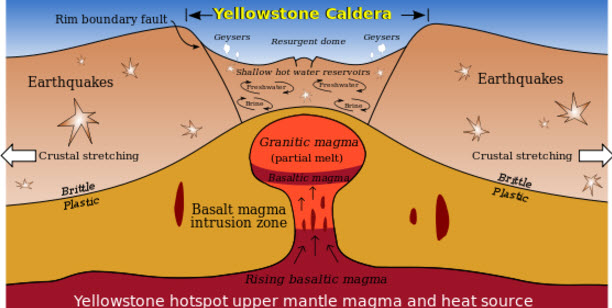
The biggest earthquake in this swarm occurred last Thursday evening. It was initially measured to be a magnitude 4.5 earthquake, but it was later downgraded to a 4.4. It was the biggest quake in the region since a magnitude 4.8 earthquake struck close to Norris Geyser Basin in March 2014. This magnitude 4.4 earthquake was so powerful that people felt it as far away as Bozeman… “The main quake was centered about 5.8 miles underground. The quake and aftershocks occurred just over 8 miles northeast from West Yellowstone, according to the U.S. Geological Service. A witness reported that she felt the building she was in move. Dozens of people reported that they felt it in and around West Yellowstone, Gardiner, Ennis, and Bozeman”. But by itself that one quake would only be of minor concern. What is troubling many of the experts is that this earthquake has been accompanied by 295 smaller ones.
[..] I would like to try to describe for you what a full-blown eruption of the Yellowstone supervolcano would mean for this country. Hundreds of cubic miles of ash, rock and lava would be blasted into the atmosphere, and this would likely plunge much of the northern hemisphere into several days of complete darkness. Virtually everything within 100 miles of Yellowstone would be immediately killed, but a much more cruel fate would befall those that live in major cities outside of the immediate blast zone such as Salt Lake City and Denver. Hot volcanic ash, rock and dust would rain down on those cities literally for weeks. In the end, it would be extremely difficult for anyone living in those communities to survive.
In fact, it has been estimated that 90% of all people living within 600 miles of Yellowstone would be killed. Experts project that such an eruption would dump a layer of volcanic ash that is at least 10 feet deep up to 1,000 miles away, and approximately two-thirds of the United States would suddenly become uninhabitable. The volcanic ash would severely contaminate most of our water supplies, and growing food in the middle of the country would become next to impossible. In other words, it would be the end of our country as we know it today.

Never privatize basic needs. Always a bad idea.
• Drug Prices Far Lower In Countries With Single-Payer Health Systems (IBT)
As the Senate has quietly been toying with the House’s proposed replacement for the Affordable Care Act, a new study, from researchers at Harvard Medical School and the University of British Columbia, found evidence that single-payer systems may lead to lower pharmaceutical prices. Could that data impact U.S. health care reform? U.S. drug prices are so high that the researchers didn’t even factor them into the study, focusing instead on other developed countries. It’s common knowledge that drug prices have been on the steady rise, increasing faster than average wages; at issue is how to push prices back down, or at least slow their escalation.
Examining the roots of high drug expenditures in 10 wealthy countries with universal health care, the study, published last week in the Canadian Medical Association Journal, discovered lower average drug prices in the nations with single-payer systems, which appeared to be better able to negotiate drug prices with pharmaceutical manufacturers. “There is some advantage to having a not-for-profit body, whether it’s a government body, a crown body… running a system without a profit motive,” said Steven Morgan, one of the authors and a professor of economics at University of British Columbia’s School of Population and Public Health. “The blunt instrument of government regulation will not in itself lower drug prices.”
Using drug price and expenditure data for 2015, the researchers established that the 10 countries with universal health care systems examined in the study — New Zealand, the United Kingdom, Canada, France, Germany, Switzerland, the Netherlands, Norway, Sweden and Australia — exhibited relatively little variation in volume of drug price purchases, with a difference as large as 41%. But the disparities in drug prices told a different story, with the two ends of the spectrum differing by 600%. For example, the average price of drug treatment per capita, per day, in New Zealand, which has a single-payer system, stood at just $23, or a third of those of the nine others. Norway, Australia, Sweden and the U.K., the other countries categorized in the study as single-payer, exhibited average daily per-capita drug expenditures of $59, $91, $56 and $81, respectively.
Switzerland, which has a multi-payer, social insurance-based system, had an average per-diem treatment cost of $171, twice as high as the other nine nations. Its fellow multi-payer countries examined in the study — France, Germany and the Netherlands — paid, per capita, on average, $106, $97 and $49, respectively, per day on drug treatments. Canadians, whose health care system the study described as “mixed,” purchased roughly the same volume of drugs as citizens of the other nine countries, but would’ve collectively saved $1.7 billion if their drug prices were comparable to those of the nine other countries, the study noted.

As long as there’s plenty free money…
• Could There Be A Bidding War For Whole Foods? (CNN)
Whole Foods will eventually be part of Amazon CEO Jeff Bezos’s empire. Or will it? Some Wall Street analysts are starting to wonder whether another retailer will come up with a higher offer and start a bidding war. Amazon announced on Friday that it was offering to pay $13.7 billion in cash for Whole Foods – a deal that values the chain of organic grocery stores at $42 a share. But Whole Foods stock closed above $42 on Friday, and it rose again Monday to top $43. That might not sound significant. But any price for Whole Foods stock that is higher than Amazon’s offer could be a sign that Wall Street thinks another company could swoop in with an even better deal. Barclays analyst Karen Short wrote in a report that she “would not be surprised” if other companies make offers for Whole Foods.
She raised her price target on the company to $48 – nearly 15% higher than Amazon’s bid. Short said in the report that “in theory, all retailers that sell food and compete with Amazon” could come up with their own offer for Whole Foods because they may “have too much to lose not to bid.” She said the likely bidders could include Walmart and Target, both of which have big grocery businesses, and the Kroger supermarket chain. She conceded it might be tough to outbid Amazon, but it could still be worth it to drive up the price and make Amazon pay more. Oppenheimer analyst Rupesh Parikh agreed. He raised his price target on Whole Foods to $45 after the Amazon deal was announced. He wrote in a report that “another bid cannot be ruled out” because other big retailers may want to do anything they can to prevent Amazon from getting even more powerful.

The worst thing you can do is let your food supply be controllled from some point a thousand miles away. But then, Amazon has killed so much community already, and no-one sproke up. It’s labeled ‘progress’.
• Amazon Will Kill Your Local Grocer (BBG)
Amazon’s done it to books. And electronics. And clothing. Now it wants to rule the grocery aisles. But Amazon still has a ways to go — the online retailing behemoth has taken a slow, yet calculated approach to attacking the grocery store. After years of testing the AmazonFresh program in its Seattle hometown, it began expanding the grocery delivery service to other cities in 2013. Today, it delivers fresh fruit and meat in parts of New York, New Jersey, Pennsylvania, Connecticut, California, Washington and Maryland. It also delivers food through its Amazon.com website and its Prime Now program. And even though research from Cowen & Co pegs Amazon’s market share of food and beverages sold online in 2015 at about 22 percent, that overall online grocery market in the U.S. is pretty small.
Out of the $795 billion Cowen expects Americans to spend on food and drinks this year, it estimates only about $33 billion of it will be spent online. That’s because it has taken shoppers a long time to grow comfortable with buying their apples, chicken breasts and granola online when they can stop by a physical store on the way home from work and actually touch and smell the food they’re buying. Companies struggle to profit from the very expensive business of picking, packing and transporting fresh food to their customers. It’s much easier to mail a video game or book, which doesn’t have to be kept cold or free of bruises. But for Amazon, the grocery business not only brings more sales, it could also make its business more profitable.
People tend to buy groceries weekly or daily, so getting them hooked on delivery justifies sending trucks out more frequently. Then any general merchandise, like a book or toy, that Amazon sells along with the food adds to profits. And since Amazon will need more trucks for grocery delivery, it could reduce its reliance on shipping companies, which have contributed to soaring costs. For now, Amazon is likely to take added grocery costs on the chin, in hopes it will pay off down the line. Growing its AmazonFresh and Prime Now offerings suggests Amazon is gearing up for the long haul in grocery. Though traditional grocers are not likely to see sales migrate to Amazon right away, that luxury won’t last. And just like bookstores, your local grocer could be toast.








